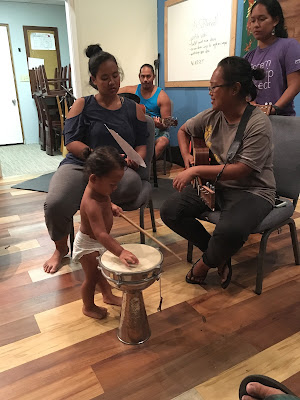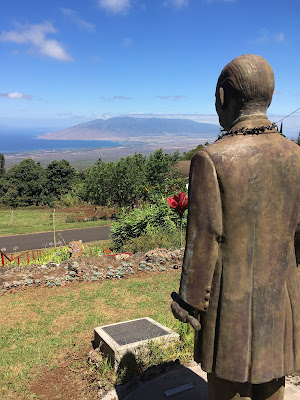One of the wonderful privileges of being with the Hawai'i InterVarsity staff team was the training. You almost can learn a lesson from anywhere in the islands- there is history, justice, and God's providence everywhere you look.
 |
| photo from Rachel |
I got to travel with two staff trainings, one on Maui in August 2018, and once in Waianae (SW Oahu) in May 2019.
Both times, we were praying for the planting of new chapters (and Maui meant planting a whole new island!) Kamalani was returning to her home island to begin this new ministry.
University of Hawai'i: Maui
So, first we did a prayer walk at UH Maui. I love how many murals Hawaii has. This 70 foot mural represents the ancient celebration of Makahiki. It was a four-month long rest and thanksgiving! All war was outlawed during this time; there were sports and dancing instead. This inspired us to pray about Sabbath and Jubilee, times of rest and renewal in our faith. College students rarely get time to rest, especially local students who are often working jobs and caring for families.
We stayed at a missionary retreat center, upstairs from a coffee shop. It was my first time sleeping on cot bunk beds!
Kula, Maui
We spent most of the trip in Maui Upcountry- the hills above town on the east side of the island. (Tourists drive up to see the volcano, Haleakala, but otherwise don't visit Upcountry.)
The IV staff team have relationships with several elders in the Chinese community there. They gave us a tour of the their history. First, we visited Sun Yat-Sen Park. Sun was a revolutionary in late 1800s China. He spent part of his youth in Hawaii, where he attended Iolani School and converted to Christianity.
In 1911, the imperial rule in China was finally overthrown. They became a Republic. (Don't be confused; the Chinese Communist Revolution wasn't until 1949.)
 |
| Values of the revolutionaries |
Sun and and his fellow revolutionaries made many plans in this small building. The Chinese society center was later built next door
 |
| from an aunty's book |
The Kwock Hing society building is now part-museum. I enjoyed seeing this grinder, used to make tofu from soybeans. Imagine traveling across the sea as a young immigrant, and hauling this with you!
We visited several historic buildings, including the Fong general store and St. John's Episcopal Church.
The church had a very English design, but we were delighted to find evidence of Chinese heritage in the altar cloth.
Waianae, Oahu
Waianae is the Southwest area of Oahu. It is mostly a less tourist-oriented area, except for the (new-ish) Aulani area, which has a big Disney resort. The area has a reputation for poverty. Jasmine said, "We don't all live in quonset huts!" (It's an old military pre-fab building with a distinct rounded roof.)
 |
| quonset hut |
Waianae is also one of those areas where I'm told, "If you're haole, people will beat you up!" Personally, I walked around and went shopping once. I minded my own business, and no one even gave me a dirty look.
Local activists, Auntie B and Auntie Lucy gave us a tour. Part of their activism is about mismanagement of natural resources. It's a common problem that new construction interferes with natural cycles of flooding and drying. Annoyed by floods, the US military built a large drainage ditch. But, this prevented the watering of the land and animals. (It also didn't solve the flooding problems: the non-absorbent concrete funneled floods more efficiently.)
Concrete heats the stream water to a higher temperature than it would be naturally. This destroys the spawning habitat, plant life, and protections for baby fish. Locals who fish for their families have one less food source.
I started recognizing some business names in the area. In my construction admin job, I coordinated payment with a waste company. Our aunty guide told us, "Sometimes construction workers dump materials out here without permission." She showed us a pile of crumbled concrete and rebar in a ditch. (The workers had to drive past the official dump site to reach the illegal dump site.)
 |
| solar panel farm |
Other areas are being used for industrial waste. The state said the land was no good. The aunties found historic photos of thriving farms. Another area may be turned into a golf course for Japanese tourists: using loads of local water. Developers like to offer "community benefits packages" to get support for projects that could have a negative impact on locals. (The aunties called it a bribe.)
They had a positive story to share: there has been a massive project in the US where when a stadium displaced poor people, the developers bought new homes for them! But... I haven't been able to find the details of that story. I'm not sure if those plans were carried through.
 |
| our retreat home, Rachel and Makaiwa |
The aunties have spoken out on different choices made for the large military base in their area. It is sad to have Hawaii be marked by chain-link fences and barbed wire. Criticizing the American military is a delicate business for the activist aunties. The military has provided work for generations of local families. Military culture is about loyalty. But, neither the land or the people have flourished during this time. It's a challenge to seek something better.
 |
| Micah, Rachel, Kamalani |










No comments:
Post a Comment